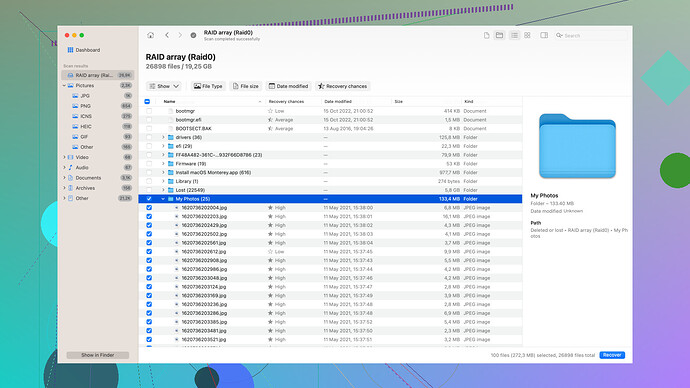I accidentally deleted some important emails from my inbox and now I can’t find them in the trash. These emails are crucial for a project I’m working on. Can anyone suggest how I might recover them?
Recovering deleted emails can be a real pain, especially when they’re critical for a project. First, let’s start with some basic steps that might help you find them:
-
Check Other Folders: Sometimes emails can be archived or moved to other folders accidentally. Make sure to check your ‘Archive’, ‘Spam’, ‘All Mail’, and any custom folders you might have.
-
Use Search Tools: If you’re using Gmail or another service with robust search capabilities, try using keywords or email addresses related to the missing emails. Sometimes search results will pull from folders you’re not thinking about.
-
Recover from Trash: You mentioned the emails aren’t in the trash, but make sure to look again. Sometimes trash is shown in chronological order and they might be buried further down the list.
-
Contact Support: Many email providers keep backups and logs for a period of time. Contact the support team of your email service (like Gmail’s help desk) and explain the situation. They might be able to restore your emails from their end.
If these steps don’t work, you might consider using specialized software to recover deleted files. One I’ve had good experience with is Disk Drill
. It’s typically used for recovering lost files on your computers, like documents and images, but some versions can also help with email recovery. Here’s the link to their website: Disk Drill. The process involves scanning your drive and looking for traces of deleted files which can then be restored. Remember to act quickly because the longer you wait, the more likely the data gets overwritten.Lastly, if you’re using a work-provided email, sync it with an external client like Outlook or Thunderbird, as these often have additional backups and recovery tools built-in.
Good luck! Hope you get those emails back.
If you’ve already checked other folders and contacted support, another thing to consider is whether you use any backup services or software. For instance, some email clients like Outlook or Thunderbird automatically create backups. You might find your deleted emails here.
Disk Drill is a solid recommendation for recovering lost emails from your hard drive, but be aware it isn’t specifically designed for email recovery, and success can be hit or miss depending on various factors. Pros: user-friendly interface, supports multiple file types. Cons: not tailored for email recovery, might not always be effective. Consider alternatives like Recuva or EaseUS Data Recovery Wizard too.
Lastly, check if you have any automated backups through your email service provider. More robust email platforms might offer retention settings that allow you to retrieve previously deleted emails within a certain time frame. Good luck!
Ah, the age-old problem of vanishing emails! Deleting crucial emails can be an absolute nightmare, but there are a few routes you can take that haven’t been covered yet by @techchizkid and @codecrafter.
One thing they didn’t mention is checking your email provider’s web-based interface if you usually access your emails through a desktop client like Outlook or Thunderbird. Sometimes, the messages might still be there if the sync between the client and the server doesn’t perfectly align. It’s an extra step, but worth a shot, especially if you’re desperate.
Another important angle is whether those emails were part of a thread. Sometimes deleted individual emails can still leave traces in conversation threads. Checking through related emails might help you retrieve essential information that was part of those deleted messages.
Additionally, there are browser extensions and add-ons that might save you here. For instance, Chrome and Firefox have a range of extensions specifically tailored for email management and data recovery. It might require some research, but investing around 20 minutes in this area could uncover a solution you hadn’t considered.
One more non-digital route: have you synced your emails with your smartphone or tablet? Sometimes mobile apps keep temporary copies of emails which might not yet sync with your inbox after deletion. It isn’t guaranteed but can be a lifesaver in some cases.
If these don’t work, you could dive deeper into Disk Drill. They’ve got specific functions and capabilities you might find pretty useful. According to the updated descriptions on their website, Disk Drill Data Recovery Software not only helps with standard file recovery but also has extensions that can probe email clients for residual data. It’s built to retrieve fragments and incomplete sets of data which can then be pieced together.
By the way, if you don’t immediately see success with Disk Drill, it’s worth trying a few additional quick searches after your initial deep scan. Sometimes subsequent small adjustments in search parameters might yield different results.
Also, if you’re utilizing a workplace email system, there might be enterprise-level solutions that can be used to retrieve your emails. Enterprise systems like Microsoft Exchange often have retention policies and backups that could be explored with the help of your IT department. It might involve some bureaucratic hurdles, but the safety net they provide is quite extensive.
For those using services like Google Workspace, their support can tap into more sophisticated recovery tools that regular Gmail users don’t have access to. While this might involve a bit of waiting and filling out forms, the chances of getting your emails back via this route could be higher.
Lastly, i’ll throw this out there: periodically, perform local backups of critical data and emails. Services like “Mailstore Home” let you archive your emails locally, providing an additional layer of security when digital missteps happen.
Capitalizing on the wisdom shared by @techchizkid and @codecrafter, combining all these strategies might give you the best shot at recovery. If all else fails, accept that digital errors sometimes happen and build a more robust system for the future to prevent similar issues.
